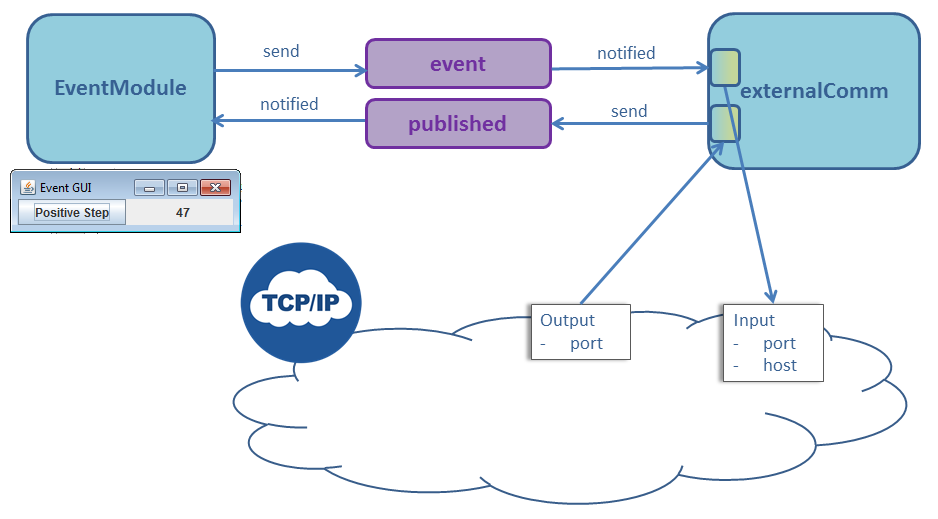Home
Categories
Dictionary
Glossary
Download
Project Details
Changes Log
What Links Here
FAQ
License
ExternalComm launcher
1 Overview
2 Launcher configuration
2.1 Launcher arguments
2.1.1 argument element
2.1.2 env element
2.1.3 propertyArgument element
2.1.4 portArgument element
2.1.5 hostArgument element
3 Example
3.1 Properties configuration
3.2 Launcher configuration
4 See also
2 Launcher configuration
2.1 Launcher arguments
2.1.1 argument element
2.1.2 env element
2.1.3 propertyArgument element
2.1.4 portArgument element
2.1.5 hostArgument element
3 Example
3.1 Properties configuration
3.2 Launcher configuration
4 See also
This article explains how to launch an external application in the ExternalComm module.
Suppose that we want to implement the

Overview
Thelauncher optional property for the ExternalComm module allows to specify the path to an external executable to launch and its launch arguments. The property specifies an XML file which defines:- The executable path
- The specification of the arguments to use to launch the executable
- Optionally, the specification of environment variables to use when launching the application
<properties> <application name="externalComm" > <module name="externalComm" > <moduleProperty key="network" value="network.xml" /> <moduleProperty key="endianness" value="littleEndian" /> <moduleProperty key="charAs8Bits" value="true" /> <moduleProperty key="launcher" value="launcher.xml" /> </module> </application> </properties>
Launcher configuration
The launcher.xsd describes the grammar of the launcherXMl file:- The top level element is a
launcherelement - It has a an
executableorshellchild representing the executable to start
executable or shell element has the following attributes:-
path(the only mandatory attribute): the path of the executable to start -
redirectIO: true if the IO of the process must be redirected to the Framework logger (will be false by default) -
wait: the time to wait before starting communcating with the process after starting it (no wait by default) -
processDir: the working directory for the process (by default the working directory of the framework JVM process will be used) -
useGlobalEnvVariables: true if the environment variables defined for the framework should be used. See also environment variables declarations for the specification of environment variables for the framework
Launcher arguments
Arguments can be specified for theexecutable or shell element. The element can have several of the following children elements:-
argumentfor an argument value -
envfor an environment variable value -
propertyArgumentfor an argument whose value is one property value for the ExternalComm module -
portArgumentfor an argument whose value is a port for the External Communication network property -
hostArgumentfor an argument whose value is a host for the External Communication network property
<name>=<value>
argument element
Theargument element specifies the value for an argument and has two attributes:-
keyspecifies the argument name -
valuespecifies the argument value
<launcher> <executable path="PublishAppli.exe"> <argument key="prop" value="20" /> </executable/> </launcher>will start the executable with:
PublishAppli.exe prop=20
env element
Theenv element specifies the value for an argument whose value is coming from an environment variable, and has two attributes:-
keyspecifies the environment variable name -
valuespecifies the environment variable value
<launcher> <executable path="PublishAppli.exe"> <env key="PROP" value="20" /> </executable/> </launcher>will start the executable with something having the same result as:
set PROP=20 PublishAppli.exe
propertyArgument element
ThepropertyArgument element specifies the value for an argument whose value is coming from one of the module properties, and has two attributes:-
keyspecifies the argument name -
propertyspecifies the property name
<properties> <application name="externalComm" > <module name="externalComm" > <moduleProperty key="network" value="network.xml" /> <moduleProperty key="launcher" value="launcher.xml" /> <moduleProperty key="theProp" value="20" /> </module> </application> </properties>And the launcher declaration:
<launcher> <executable path="PublishAppli.exe"> <propertyArgument key="prop" property="theProp" /> </executable/> </launcher>will start the executable with:
PublishAppli.exe prop=20
portArgument element
TheportArgument specifies the value for an argument whose value is coming from the port of one of the network property channels:-
keyspecifies the argument name -
channelspecifies the channel name
<network> <channel name="event" type="input" port="8080" > <service name="published" /> </channel> </network>And the launcher declaration:
<launcher> <executable path="PublishAppli.exe"> <portArgument key="prop" channel="event" /> </executable/> </launcher>will start the executable with:
PublishAppli.exe prop=8080
hostArgument element
ThehostArgument specifies the value for an argument whose value is coming from the host of one of the network property channels:-
keyspecifies the argument name -
channelspecifies the channel name
<network> <channel name="event" type="input" port="8080" host="127.0.0.1" > <service name="published" /> </channel> </network>And the launcher declaration:
<launcher> <executable path="PublishAppli.exe"> <hostArgument key="prop" channel="event" /> </executable/> </launcher>will start the executable with:
PublishAppli.exe prop=127.0.0.1
Example
Main Article: External Communication Launcher tutorial
Suppose that we want to implement the
publishAppli of the first tutorial in CSharp. We will have the following architecture:
Properties configuration
The properties configuration will be:<properties> <application name="externalComm" > <module name="externalComm" > <moduleProperty key="network" value="network.xml" /> <moduleProperty key="endianness" value="littleEndian" /> <moduleProperty key="charAs8Bits" value="true" /> <moduleProperty key="launcher" value="launcher.xml" /> </module> </application> </properties>
Launcher configuration
The launcher configuration will be:<launcher> <executable path="PublishAppli.exe" redirectIO="true" wait="500ms"/> </launcher>
See also
- External Communication: The built-in External Communication application allows to communicate through UDP or TCP with any external process
- External Communication Launcher tutorial: This article is a tutorial which explains how to use the launcher for the External Communication with a C# executable
×
![]()
Categories: builtin-applis